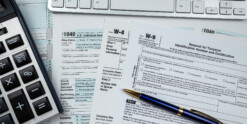Hitting the big 5-0 can be a time of reflection. Life is changing. The kids may be leaving the nest. Your career, now in full swing, could become more demanding. And, of course, that once-distant dream of retirement is becoming more of a reality.
Let’s start with a few basic concepts. I am a big believer in the TSL strategy, which stands for taxes (T), savings (S) and life (L). Under this approach, approximately 30 percent of your income should go to taxes, 20 percent should go to savings, and the remaining 50 percent should go to life expenses. But, during your 50s, you could well decide to tweak this formula and your budget so that savings becomes a bigger percentage.
As to loans, keep up with financial best practices during this decade by continuing to pay down “bad” debt aggressively. No one wants to head into retirement saddled with credit card balances. Not only are they bad for your budget, they can cost you a small fortune if you just pay the minimum each month. Needless to say, be very careful about taking on additional consumer debt at this life stage.
1. Playing “catch-up” with contributions.
Under the current rules for catch-up contributions, workers age 50 and older can put an annual max of $7,000 into an IRA ($6,000 max plus a $1,000 catch-up) and up to $25,000 into a 401(k) ($19,000 max plus $6,000 catch-up). For perspective, if you can stash the $25,000 each year into a 401(k) for a decade, you’d have an additional $300,000 plus for retirement, assuming your investments generate a conservative 5 percent average annual return. If your employer offers to match a portion of your contribution, that, my friends, is free money! Don’t leave it on the table.
2. Mortgage? What mortgage?
The happiest retirees enter their post-career life either mortgage-free or within five years of hosting a mortgage-burning party. This insight comes from the research I conducted for my book, “You Can Retire Sooner Than You Think.” Entering retirement mortgage-free removes the financial burden of having yet another monthly payment to deal with, and offers the added benefits of freeing cash to cover other home costs, including maintenance, insurance and taxes.
Even if you can’t dump a pile of money on your mortgage right now, consider paying a little extra each month. This way, you can shave months (or years) off your payoff date. And you’ll be further on the road most traveled by the happiest retirees — living mortgage-free.
3. Stick with stocks.
Don’t ditch your investments in stocks just because retirement is around the corner. I hear from would-be and full-time retirees who ask me: “Wes, is it safe to still be in stocks right now?” It’s a legitimate question. After all, compared to cousin investment vehicles like bonds, stocks are considered higher risk. But it’s helpful to remember that stocks can also bring higher rewards.
While there is no one-size-fits-all answer, I do have a useful guideline. The 15/50 Stock Rule says that if you believe you have at least 15 years left on this earth, you should have at least 50 percent allocated to stocks, and the remaining balance in various bonds and cash. The stock allocation can be made up of either dividend-payers or growth stocks. You just need to keep an eye on your portfolio and reallocate as necessary to prevent stocks from creeping far beyond the 50 percent mark. This new rule of thumb tries to help you strike a balance between risk and reward.
The savings race to retirement is a marathon. Hopefully, you’ve kept up a good pace from the starting gun. But regardless of where you are in the pack at age 50, know that kicking up your efforts at this point can make a huge difference in where you finish — and the resulting prize money.
Read the full AJC article here.
DISCLOSURE
This information is provided to you as a resource for informational purposes only and should not be viewed as investment advice or recommendations. Investing involves risk, including the possible loss of principal. There is no guarantee offered that investment return, yield or performance will be achieved. There will be periods of performance fluctuations, including periods of negative returns. Past performance is not indicative of future results when considering any investment vehicle. This information is being presented without consideration of the investment objectives, risk tolerance, or financial circumstances of any specific investor and might not be suitable for all investors. This information is not intended to, and should not, form a primary basis for any investment decision that you may make. Always consult your own legal, tax or investment adviser before making any investment/tax/estate/financial planning considerations or decisions.













